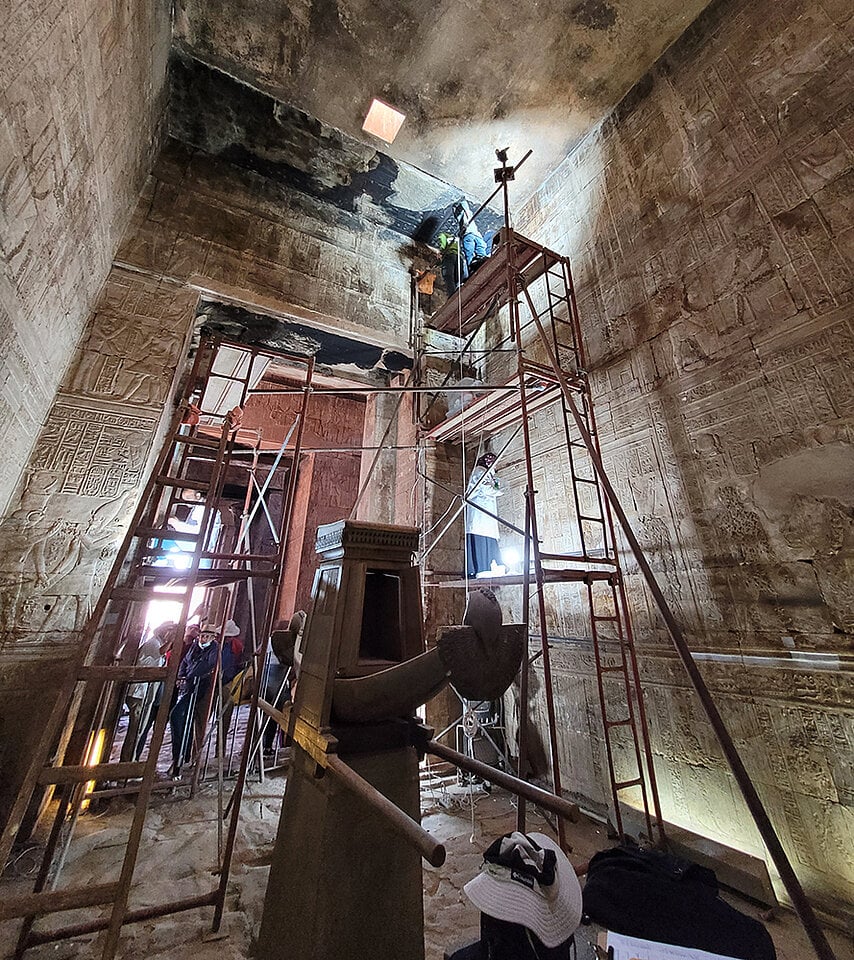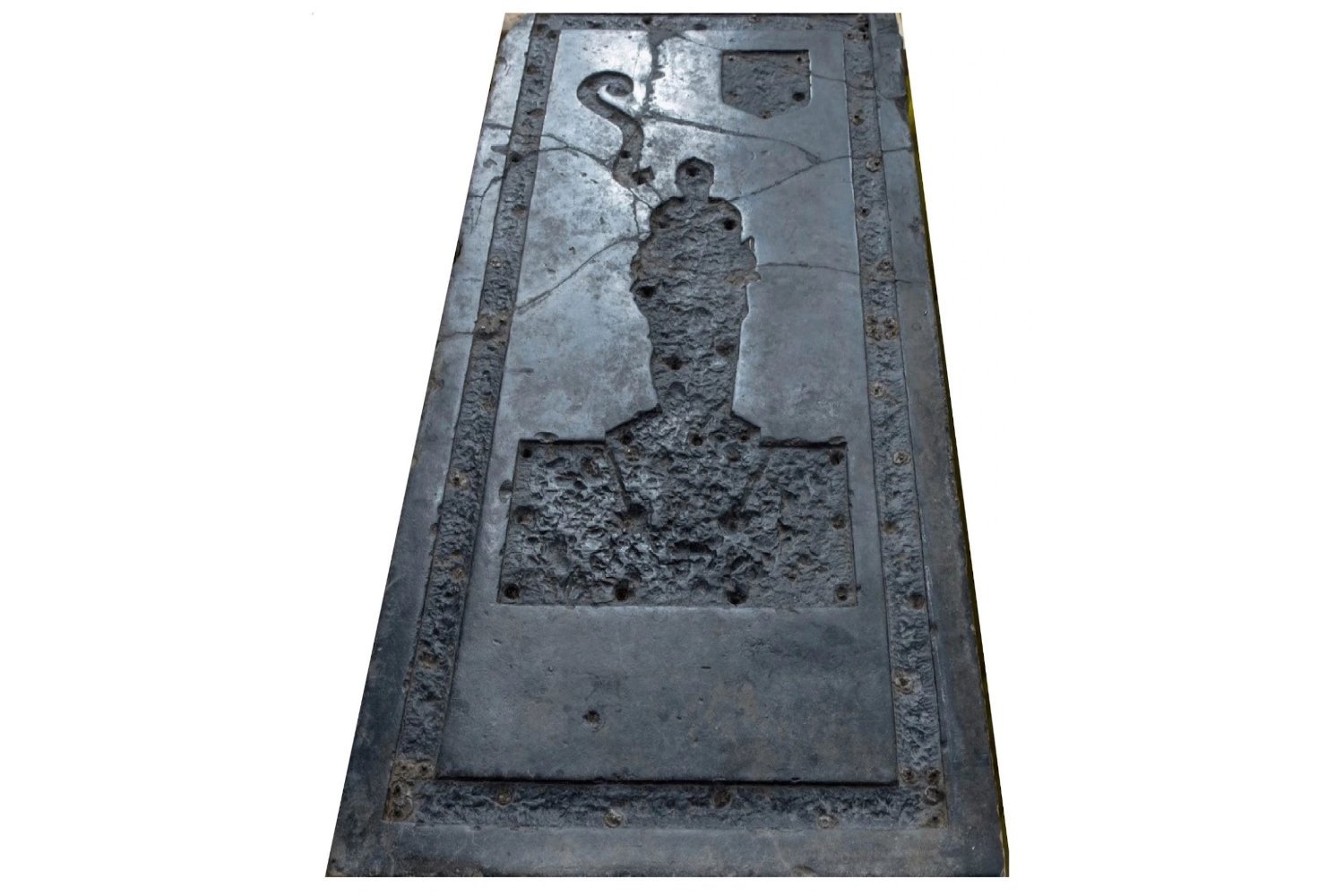 Victoria Altmann-Wendling / Universität Würzburg
Victoria Altmann-Wendling / Universität WürzburgThe ongoing restoration of one of the largest temples in Egypt has revealed colorful paintings, gold leaf decorations, and testimonies by priests, providing a rare glimpse of what the ancient places of worship may have looked like in the past.
A team of researchers from Egypt and Germany has unveiled the initial findings from efforts to restore a section of the Edfu Temple in Upper Egypt, where ancient carvings colored with bright blue paint and figures gilded in gold cover the walls and columns. The restoration efforts also found graffiti written in the Demotic script, which served as direct testimony by priests entering the temple.
The Edfu Temple was dedicated to the worship of the falcon-headed god Horus, and is one of the best preserved temples in Egypt. The collaborative effort by the Supreme Council of Antiquities in Egypt and the University of Würzburg in Germany to restore the temple has been ongoing since 2021. The project seeks to clean its walls and document the different texts and scenes painted across the building.
 Victoria Altmann-Wendling / Universität Würzburg
Victoria Altmann-Wendling / Universität Würzburg
A team of restorers cleaned up dust, bird poop, and soot from the higher wall areas of the barque sanctuary, uncovering some of the paintings that once covered the entire walls of the temple. The team also found traces of gold hues that were used to gild raised inscriptions, depicting gold jewelry, emblems and deities.
“The fact that the gods were completely gilded is particularly interesting,” Victoria Altmann-Wendling, project manager and research fellow at the Horus Beḥedety Project at University of Würzburg, said in a statement. “We find this in the textual sources that describe the flesh of the gods as consisting of gold.”
Colorful paint and gold were commonly used to adorn columns and obelisks in Ancient Egypt, according to the University of Würzburg. However, most of these elements have faded over time and are rarely found today. Some of the inscriptions uncovered in the Edfu Temple restoration project suggest that some of its buildings were covered with an overlay of metal foils made of gilded copper, Ayman Ashmawy, head of the Egyptian Antiquities Sector at the Supreme Council of Antiquities, said in a statement.
The restoration efforts also uncovered dipinti, or graffiti written in ink, in Demotic script (the cursive script derived from ancient Egyptian hieratic). The graffiti is the personal inscriptions written by priests as they entered the temple, with prayers addressed to Horus that reveal more insight into Ancient Egyptian religious practices. The Edfu Temple contains more religious texts and ritual scenes than almost any other Egyptian temple.
More: Dazzling Carvings of Egyptian Pharaohs Found in the River Nile

It seems like a particularly tough Jeopardy! answer: Where did the oldest tombstone in America come from? Despite being over 400 years old, there hasn’t been a conclusive answer, making the black limestone monument something of a mystery, until now.
The tombstone, often considered the oldest in the United States, was found in Jamestown, Virginia, the first permanent English settlement in the Americas. While historians have a decent handle on who it belonged to, how it got there has remained somewhat of a mystery. Early settlers had no experience in carving tombstones. Determining its origins offers not just a deeper understanding of colonial America but also helps researchers better grasp the era’s trade routes.
The stone was originally laid in the floor of Jamestown’s church, built in 1617. Some time in the 1640s, it was moved as the church was expanded. Over the next 250 or so years, the tombstone was forgotten, until it was discovered and repaired in 1901. In 1906, it was moved to the historical colony’s then-new Memorial Church.
The outline of a person wearing armor, and the presence of what is likely a shield and sword in the decorative design, suggests the tombstone was constructed in honor of a knight. The identity of said knight remains somewhat in dispute. While Jamestown’s first resident governor, Sir Thomas West, who died in 1618 while on a ship to the colony, was a knight, the geologists note that there’s no historical record tying the stone to him. There’s more evidence connecting it to Sir George Yeardley, a colonial governor, and one of the earliest slave owners in American history. A possible reference was found in the will of Yeardley’s step-grandson, asking that his own tombstone have the same inscription as the one on the “broken tomb.”
Whether it’s West or Yeardley, what’s clear is that the stone was meant for someone of means. Engraved tombstones in seventeenth century Virginia were a status symbol for affluent colonists. But there are no rocks like this near Jamestown, meaning they must have been imported from somewhere.
To figure out that point of origin, Marcus Key, a geophysicist at Dickinson College, had to think very, very small. He looked at microfossils embedded in the limestone.
In the ensuing study, published in the International Journal of Historical Archaeology, Key noted that fossils are often more unique to a time and space than chemical composition due to the evolutionary process. Limestone is also a great medium for preserving fossils, as it is resistant to heat and pressure.
Key cut thin slivers off preserved fragments of the tombstone and found several microfossils of single-celled organisms called foraminiferans. The ages of the organisms varied: Some went as far back as the Mississippian Epoch, almost 360 million years ago. Several of the species were endemic to a single area of Europe, which included parts of England, Ireland, and Belgium.
“These species did not co-occur anywhere in North America,” Key wrote in the study. “The knight’s tombstone had to be imported from Europe. Historical evidence of similar colonial tombstones around the Chesapeake Bay suggests the source was Belgium.”
Key observed that black, faux-marble tombstones were all the rage in England at the time of the Jamestown colony, and prominent residents would have been eager to get in line with the hippest burial trends. He concluded that the stone likely was found in Belgium, shipped to London, where it was carved and had now-lost brass inlays installed. Then, it was loaded onto a ship and sent to the New World.
That must have cost a pretty penny, despite conditions in Jamestown that could be brutal. There’s some evidence that things could get so bad, the colonists had to resort to cannibalism. Even so, some right knight decided to shell out some big bucks to import a memorial to himself.
Rich people problems, am I right?

Qanats can date back 3,000 years, but can be really tricky to find, especially in politically volatile countries.